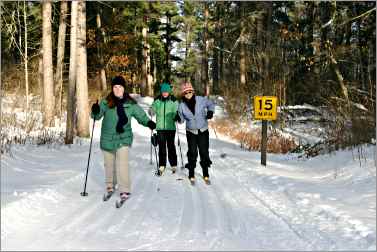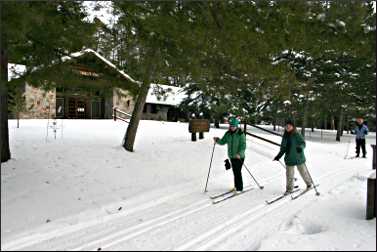Itasca in winter
After snow flies, visitors zip around Minnesota's beloved state park on skis and snowshoes.

© Beth Gauper
In winter, only the most dedicated pilgrims make the trip to Itasca, Minnesota's most revered state park.
Yet the park is beautiful without its forest canopy. It's easy to see its bones, the lumpy quilt of knobs and kettles laid down by retreating glaciers.
It's easy to see the 300-year-old pines that escaped loggers. And it's easier to listen — to the sassy chatter of a squirrel, the prehistoric croak of a crow, the rat-a-tat of a woodpecker.
In winter, the park grooms 32 kilometers of trails for classic and skate skiing. On the trails, skiers see the legacy of Jacob Brower, the far-sighted surveyor who, in 1891, used his own salary to start piecing together the state's first state park.
One January, I drove up to the park with my daughter, my niece and my snow-starved sister from Florida.
Before darkness fell, we skied along the lake to the headwaters, where the Mississippi begins its run to the Gulf of Mexico. The little clearing, packed with tourists in summer, was so quiet our clicking skis seemed to echo.
Our lodgings were just up from the trail at the Headwaters Inn, the 1923 log former park headquarters. It has a cozy wood-burning fireplace and modern kitchen and for many years was a Hostelling International hostel before the park took it back.
In the morning, we skied the Ozawindib Trail, named for the Ojibwe guide who led Henry Schoolcraft to the headwaters, forms the spine of the network. It was too hilly for Lynn, my flatlander sister, so she headed back to the lake trail and the visitor center's gas fireplaces.
I skied to Deer Park Trail, where the tiny islands of Deer Park Lake were top-heavy with pines that reach eight stories into blue sky. A bark rang out in the distance, a dog or one of Itasca's own pack of wolves.
The terrain rose and fell under my skis as I crossed back to Ozawindib Trail; at Itasca, the hardwood and pine forest makes a last stand before flattening into prairie.

© Beth Gauper
The third day, we skied along the lake and through the campground, and Lynn found her snow legs.
"I was a totally clumsy klutz, and then I was flying," she marveled. "This is a unique experience for anyone, even if they're not from Florida."
In the guest book, she wrote, "What a cold and refreshing change from Florida!"
In Itasca, winter is everything it's cracked up to be.
Trip Tips: Winter in Minnesota's Itasca State Park
Getting there: The fastest route from the Twin Cities is I-94 to the Clearwater exit, U.S. 10 to Motley, Minnesota 64 to 200 and Minnesota 200/U.S. 71 west to the park. It takes a little more than four hours in good conditions.
For more on Itasca, see The people's park.
Accommodations: Most of the park's accommodations close for the winter. But near Douglas Lodge, the Itasca Suites stay open. They occupy two buildings that sit on either side of a large asphalt parking lot.
There's no view, but the suites are attractively furnished, and they have kitchenettes and satellite televisions. Reserve online or at 866-857-2757.
The log Headwaters Inn on Lake Itasca, the former park headquarters and then a Hostelling International hostel, now is operated by the park and offers six bedrooms with full beds. Guests share three bathrooms, a large kitchen, dining room and great room with a stone wood-burning fireplace.
There's also a guesthouse and cabin, both with full kitchens, at La Salle Lake State Recreation Area, eight miles north of Itasca.
The three-bedroom Black Bear Guesthouse sleeps 10 in four queen beds and a futon and rents for $325. The two-bedroom Lone Wolf Cabin sleeps four in two queen beds and rents for $200.
Itasca State Park: It has a full-time naturalist, so check year-round for special events and programs, 218-699-7251. The park offers two lantern-lit candlelight ski evenings each winter.
Skiing: A Minnesota ski pass is required, $10 daily, $25 annual. The visitors center sells daily passes.
Snowshoeing: The park rents snowshoes. The 3.2-kilometer Dr. Roberts Trail, 3.1-kilometer Mary Lake Trail near Douglas Lodge, 2.2-kilometer Brower Trail and 1.8-kilometer Schoolcraft Trail near the Headwaters are groomed for snowshoeing.
The 3/4-mile Twinkle Light Trail at Bear Paw Campground is packed for snowshoeing or hiking and is lighted daily from dusk to 10 p.m.